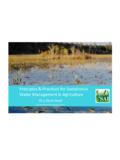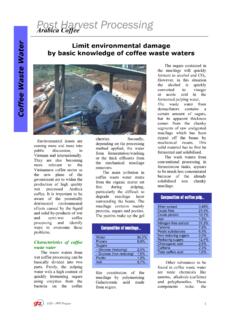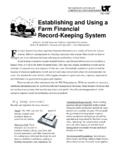Transcription of 1. Improve water use efficiency - SAI Platform
1 Fact Sheet 3: The 10 key issues for water Management at a farm level water Group One of the primary objectives of sustainable agriculture is ensuring that farmers can intensify agricultural production while using water more efficiently and reducing environmental degradation. This fact sheet outlines 10 measures that farmers can undertake to Improve their water efficiency and can be applied to different types of farming systems. Some measures include conducting water irrigation scheduling, reducing water pollution, using of harvested rainwater, checking for water losses in distribution systems, improving water management, reuse and recycling.
2 In addition, good agricultural practices as managing soil fertility and reducing land degradation are important for increasing water efficiency . These include more reliable and precise distribution and application of irrigation water (such as drip irrigation), supplemental and deficit irrigation, and soil conservation practices. 1. Improve water use efficiency There is still ample scope for water use efficiency improvements (getting more yields per cubic metre of water ) and reducing the risk of causing diffuse pollution through over-irrigating by improving the farm irrigation system. One way of doing so is implementing a drip irrigation system which enhances irrigation efficiency relative to conventional techniques (such as gravity systems, which include flood irrigation of entire fields, and furrow irrigation using shallow channels or ditches to carry water to the crop).
3 See TB on drip irrigation and TB on irrigation systems for more detail. Farmers using a pumping systems to irrigate their fields should ensure that the pump and pipe size are fitting with their needs, thus avoiding water and energy overuse and consequent leakages. An important component of the evaluation of infield irrigation performance is the assessment of the irrigation uniformity. Ideally, the average volume applied should meet the crop requirements, avoiding over or under-irrigation. Thus, a major aim of irrigation management is to apply water with a high degree of uniformity through the field. See Calculating Distribution Uniformity for more information on how to assess the uniformity of the irrigation.
4 In addition, to Improve the performance of infield application systems it is recommended to ensure that land is properly levelled (in the case of flood or furrow irrigation), to check the condition of the irrigation system, pumps, mains and hydrants periodically and to repair worn items such as seals (for overhead and drip systems). 2. Use Alternative sources of water An alternative source of water that farmers can use is rainwater collected from containers, roofs of farm buildings. This source of water can be used for a variety of activities, including washing down yards and washing equipment.
5 The quantity of rain farmers can harvest will depend on the location of the farm and the climatic conditions as well as size, slope and material of the collecting container. See TB on Rainwater Harvesting for more detail. water Fact Sheet 3: The 10 key issues for water Management at a farm level water Group Group 3. Prevent and repair leaks Prevention and repairing infield leaks can save water in the farm . A simple ways to detect leaks is to check leaks visually by looking at unusually damp areas of the farm and unexpected vegetation (for a recent leak) and reduced vegetation (for a long-term leak, because of reduced soil quality).
6 A more complicated way of detecting leaks in case the farmer could not detected visually is by using special leak detectors as listening sticks, remote listening devices, pressure fluctuation sensors. To prevent leak it is recommendable to insulate pipes, to install drinking systems properly, read water metering frequently and to implement and fit trigger controls in all hoses, hand lances and washing equipment. 4. Schedule Irrigation Irrigation scheduling takes into account the evapotranspiration rate and soil moisture deficits and climate conditions to calculate the exact amount crop water requirement per day.
7 An efficient use of water results when providing the crop with the exact amount of water . The Food and Agriculture Organization (FAO) provides guidance on how to calculate appropriate irrigation. CROPWAT is a practical tool that conducts complete standard calculations for evapotranspiration and crop water requirements and crop irrigation requirements and, more specifically, design and manage irrigation schemes. See TB on Irrigation Scheduling for more detail. 5. Understand soil structure and manage moisture conditions Understanding how soil properties affect water storage before designing an adequate irrigation system can help optimising water use by plants.
8 Soil moisture depends on climate, topography and other soil characteristics. Some plant species are highly adaptable and can tolerate a range of moisture conditions. Others have very specific moisture requirements. See TB on The importance of soil on water for further detail. 6. Minimise land degradation Reducing land degradation is important for increasing water use efficiency and also minimise soil erosion. No-tillage, for example, not only protects soil architecture through minimal soil disturbance, but also can increase water use efficiency by permitting an efficient water and nutrient cycling as a result of root development and stable biological porosity.
9 These soil organisms undertake biological ripping that improves soil structure, preventing compaction and facilitating root penetration. See TB on Use of conservation tillage system. Fact Sheet 3: The 10 key issues for water Management at a farm level water Group 7. Manage pesticides on a responsible way The use of pesticides can result on water pollution if not managed on a responsible way. It is recommended to assess the risk of pesticides use on water resources. There are some tools available such as the Field crops indicator developed by the Centre for Agriculture and Environment (CLM) and PRiME (Pesticide Risk Mitigation Engine).
10 The adoption of Integrated Pest Management (IPM) practices can reduce pesticide use which in turn can reduce the impact on surface and groundwater from pest management practices. For more information on IMP and the effect of pesticides on water sources see TB on IPM: A guide to protect water courses for information about integrated pest management. 8. Avoid water pollution Agricultural processes such as tillage, ploughing of the land, use of pesticides, fertilisers, over-irrigation, spreading of slurries and manure can cause the contamination of water if not properly managed. Some ways of avoiding water pollution is by implementing conservation measures such as riparian buffers, integrated pest management and manure management.












